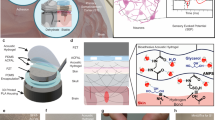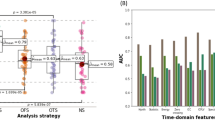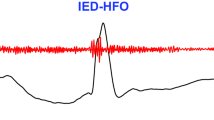Abstract
Transcranial focused ultrasound has shown promising non-invasive therapeutic effects for drug-resistant epilepsy due to its spatial resolution and depth penetrability. However, current manual strategies, which use fixed neurostimulation protocols, cannot provide precise patient-specific treatment due to the absence of ultrasound wave-insensitive closed-loop neurostimulation devices. Here, we report a shape-morphing cortex-adhesive sensor for closed-loop transcranial ultrasound neurostimulation. The sensor consists of a catechol-conjugated alginate hydrogel adhesive, a stretchable 16-channel electrode array and a viscoplastic self-healing polymeric substrate, and is coupled to a pulse-controlled transcranial focused ultrasound device. It can provide conformal and robust fixation to curvy cortical surfaces, and we show that it is capable of stable neural signal recording in awake seizure rodents during transcranial focused ultrasound neurostimulation. The sensing performance allows real-time detection of preseizure signals with unexpected and irregular high-frequency oscillations, and we demonstrate closed-loop seizure control supervised by intact cortical activity under ultrasound stimulation in awake rodents.
This is a preview of subscription content, access via your institution
Access options
Access Nature and 54 other Nature Portfolio journals
Get Nature+, our best-value online-access subscription
$32.99 / 30 days
cancel any time
Subscribe to this journal
Receive 12 digital issues and online access to articles
$119.00 per year
only $9.92 per issue
Buy this article
- Purchase on SpringerLink
- Instant access to full article PDF
Prices may be subject to local taxes which are calculated during checkout






Similar content being viewed by others
Data availability
Source data are provided with this paper. Other data that support the findings of this study are available from the corresponding author upon reasonable request.
Code availability
The customized MATLAB codes used for in vivo demonstration and analysing ECoG signals in this work are available from the corresponding author upon reasonable request.
References
Fisher, R. S. & Velasco, A. L. Electrical brain stimulation for epilepsy. Nat. Rev. Neurol. 10, 261–270 (2014).
Ryvlin, P. et al. Neuromodulation in epilepsy: state-of-the-art approved therapies. Lancet Neurol. 20, 1038–1047 (2021).
Min, B. K. et al. Focused ultrasound-mediated suppression of chemically-induced acute epileptic EEG activity. BMC Neurosci. 12, 23 (2011).
Chen, S. G. et al. Transcranial focused ultrasound pulsation suppresses pentylenetetrazol induced epilepsy in vivo. Brain Stimul. 13, 35–46 (2020).
Chu, P. C. et al. Pulsed-focused ultrasound provides long-term suppression of epileptiform bursts in the kainic acid-induced epilepsy rat model. Neurotherapeutics 19, 1368–1380 (2022).
Murphy, K. R. et al. A tool for monitoring cell type–specific focused ultrasound neuromodulation and control of chronic epilepsy. Proc. Natl Acad. Sci. USA 119, e2206828119 (2022).
Lee, C. C. et al. Pilot study of focused ultrasound for drug‐resistant epilepsy. Epilepsia 63, 162–175 (2022).
Berényi, A. et al. Closed-loop control of epilepsy by transcranial electrical stimulation. Science 337, 735–737 (2012).
Ouyang, W. et al. A wireless and battery-less implant for multimodal closed-loop neuromodulation in small animals. Nat. Biomed. Eng. 7, 1252–1269 (2023).
Liu, J. et al. Syringe-injectable electronics. Nat. Nanotechnol. 10, 629–636 (2015).
Zhao, S. et al. Tracking neural activity from the same cells during the entire adult life of mice. Nat. Neurosci. 26, 696–710 (2023).
Zijlmans, M. et al. Changing concepts in presurgical assessment for epilepsy surgery. Nat. Rev. Neurol. 15, 594–606 (2019).
Staba, R. J. et al. Quantitative analysis of high-frequency oscillations (80–500 Hz) recorded in human epileptic hippocampus and entorhinal cortex. J. Neurophysiol. 88, 1743–1752 (2002).
Viventi, J. et al. Flexible, foldable, actively multiplexed, high-density electrode array for mapping brain activity in vivo. Nat. Neurosci. 14, 1599–1605 (2011).
Chiang, C.-H. et al. Development of a neural interface for high-definition, long-term recording in rodents and nonhuman primates. Sci. Transl. Med. 12, eaay4682 (2020).
Khodagholy, D. et al. NeuroGrid: recording action potentials from the surface of the brain. Nat. Neurosci. 18, 310–315 (2015).
Lee, W. et al. Transparent, conformable, active multielectrode array using organic electrochemical transistors. Proc. Natl Acad. Sci. USA 114, 10554–10559 (2017).
Tchoe, Y. et al. Human brain mapping with multithousand-channel PtNRGrids resolves spatiotemporal dynamics. Sci. Transl. Med. 14, eabj1441 (2022).
Vomero, M. et al. Glassy carbon electrocorticography electrodes on ultra-thin and finger-like polyimide substrate: performance evaluation based on different electrode diameters. Materials 11, 2486 (2018).
Vomero, M. et al. Conformable polyimide-based μECoGs: bringing the electrodes closer to the signal source. Biomaterials 255, 120178 (2020).
Besson, P. et al. Small focal cortical dysplasia lesions are located at the bottom of a deep sulcus. Brain 131, 3246–3255 (2008).
Kim, D.-H. et al. Dissolvable films of silk fibroin for ultrathin conformal bio-integrated electronics. Nat. Mater. 9, 511–517 (2010).
Shi, Z. et al. Silk‐enabled conformal multifunctional bioelectronics for investigation of spatiotemporal epileptiform activities and multimodal neural encoding/decoding. Adv. Sci. 6, 1801617 (2019).
Tringides, C. M. et al. Viscoelastic surface electrode arrays to interface with viscoelastic tissues. Nat. Nanotechnol. 16, 1019–1029 (2021).
Jiang, Y. et al. Topological supramolecular network enabled high-conductivity, stretchable organic bioelectronics. Science 375, 1411–1417 (2022).
Tybrandt, K. et al. High‐density stretchable electrode grids for chronic neural recording. Adv. Mater. 30, 1706520 (2018).
Fallegger, F. et al. MRI‐Compatible and conformal electrocorticography grids for translational research. Adv. Sci. 8, 2003761 (2021).
Song, S. et al. Deployment of an electrocorticography system with a soft robotic actuator. Sci. Robot. 8, eadd1002 (2023).
Mueller, J. et al. Simultaneous transcranial magnetic stimulation and single-neuron recording in alert non-human primates. Nat. Neurosci. 17, 1130–1136 (2014).
Kim, M. G. et al. Image-guided focused ultrasound modulates electrically evoked motor neuronal activity in the mouse peripheral nervous system in vivo. J. Neural Eng. 17, 026026 (2020).
Suarez-Castellanos, I. M. et al. Spatio-temporal characterization of causal electrophysiological activity stimulated by single pulse focused ultrasound: an ex vivo study on hippocampal brain slices. J. Neural Eng. 18, 026022 (2021).
Sarica, C. et al. Toward focused ultrasound neuromodulation in deep brain stimulator implanted patients: ex-vivo thermal, kinetic and targeting feasibility assessment. Brain Stimul. 15, 376–379 (2022).
Airan, R. D. et al. Noninvasive targeted transcranial neuromodulation via focused ultrasound gated drug release from nanoemulsions. Nano Lett. 17, 652–659 (2017).
Deng, J. et al. Electrical bioadhesive interface for bioelectronics. Nat. Mater. 20, 229–236 (2021).
Choi, H. et al. Adhesive bioelectronics for sutureless epicardial interfacing. Nat. Electron. 6, 779–789 (2023).
Lee, C. et al. Bioinspired, calcium-free alginate hydrogels with tunable physical and mechanical properties and improved biocompatibility. Biomacromolecules 14, 2004–2013 (2013).
Kang, J. et al. Tough and water-insensitive self-healing elastomer for robust electronic skin. Adv. Mater. 30, 1706846 (2018).
Younan, Y. et al. Influence of the pressure field distribution in transcranial ultrasonic neurostimulation. Med. Phys. 40, 082902 (2013).
Yang, K. et al. Polydopamine-mediated surface modification of scaffold materials for human neural stem cell engineering. Biomaterials 33, 6952–6964 (2012).
Blackmore, J. et al. Ultrasound neuromodulation: a review of results, mechanisms and safety. Ultrasound Med. Biol. 45, 1509–1536 (2019).
Buzsaki, G. & Draguhn, A. Neuronal oscillations in cortical networks. Science 304, 1926–1929 (2004).
Stypulkowski, P. H. et al. Brain stimulation for epilepsy–local and remote modulation of network excitability. Brain Stimul. 7, 350–358 (2014).
Aubry, J. F. et al. ITRUSST consensus on biophysical safety for transcranial ultrasonic stimulation. Preprint at arXiv arXiv:2311.05359 (2023).
Ben‐Ari, Y. E. et al. Long‐lasting modification of the synaptic properties of rat CA3 hippocampal neurones induced by kainic acid. J. Physiol. 404, 365–384 (1988).
Mouri, G. et al. Unilateral hippocampal CA3-predominant damage and short latency epileptogenesis after intra-amygdala microinjection of kainic acid in mice. Brain Res. 1213, 140–151 (2008).
Fomenko, A. et al. Low-intensity ultrasound neuromodulation: an overview of mechanisms and emerging human applications. Brain Stimul. 11, 1209–1217 (2018).
FDA Guidance. Information for Manufacturers Seeking Marketing Clearance of Diagnostic Ultrasound Systems and Transducers (FDA, 2019); www.fda.gov/media/71100/download
White, A. M. et al. Efficient unsupervised algorithms for the detection of seizures in continuous EEG recordings from rats after brain injury. J. Neurosci. Methods 152, 255–266 (2006).
Mouse skull and brain. Open source for 3D model. Thingverse www.thingiverse.com/thing:3079327 (2018).
Lab rat. Open source for 3D model. Sketchfab https://sketchfab.com/3d-models/lab-rat-9f1e720a87ac40e7bda7096d760cced7 (2024).
Acknowledgements
This study was dominantly supported by the National Research Foundation of Korea grant funded by the Korean government (Ministry of Science and ICT, MSIT) (grant nos. 2020R1C1C1005567 (D.S.), 2022M3E5E9018583 (D.S.), RS-2023-00208262 (M.S.), 2021R1A2C2008829 (Hyungmin Kim)) and Institute for Basic Science (grant no. IBS-R015-D1). This work was also supported by MSIT, Korea, under the ICT Creative Consilience Program (grant no. IITP-2023-2020-0-01821) supervised by the IITP (Institute for Information and Communications Technology Planning and Evaluation). This study was also partially funded by KIST Institutional Program (grant no. 2E33141) and the National Research Foundation of Korea grant funded by the Korean government (Ministry of Science and ICT, MSIT) (grant no. 2022M3E5E9016506 (J. Kim)).
Author information
Authors and Affiliations
Contributions
D.S. and Hyungmin Kim conceived the project and M.S., Hyungmin Kim and D.S. supervised the project. S.L. and J. Kum conducted all experiments with assistance from co-authors. S.K. and J.H.C. assisted materialization and ex vivo adhesion test. H.J. performed the mechanical simulation and analysed the dynamic stress distribution. S.A. assisted harvesting rodents’ brain tissues for histological analysis. S.J.C., Hyeok Kim and H.-S.H. conducted histological imaging and provided the interpretation of the biological and histological data. W.L. and K.J.Y. provided technical advice. D.S., Hyungmin Kim, M.S. and J. Kim provided financial support to the project. S.L., J. Kum, M.S., Hyungmin Kim and D.S. analysed the data and wrote the manuscript with input from all the co-authors.
Corresponding authors
Ethics declarations
Competing interests
The authors declare no competing interests.
Peer review
Peer review information
Nature Electronics thanks Xinge Yu and the other, anonymous, reviewer(s) for their contribution to the peer review of this work.
Additional information
Publisher’s note Springer Nature remains neutral with regard to jurisdictional claims in published maps and institutional affiliations.
Extended data
Extended Data Fig. 1 Immunohistology analysis of SMCA sensor-attached rodent brain tissue. The fluorescence microscopic images show double labelling for an immunofluorescent astrocytic marker GFAP and microglia/macrophage marker Iba-1 at the implantation sites of both positive control (Sham) and SMCA sensor (SMCA). Cell nuclei were DAPI-stained for visualization.
a, b, Representative images of the dissected brain tissue harvested from same animal including contralateral Sham (control area only with craniotomy procedure) (a) and ipsilateral SMCA (SMCA sensor-attached area) (b) hemisphere after 4 weeks of implantation. c, d, Representative images of the dissected brain tissue harvested from Sham (pristine tissue) (c) and SMCA (SMCA sensor-attached brain (d) animal groups after 24 weeks of implantation. e, f, Average immune responsive activation area of GFAP (e) and Iba-1 (f) for hemispheric area of the brain tissues including Sham and SMCA groups after 4 weeks and 24 weeks of implantation. In case of the GFAP activation area, unpaired two-tailed t-test: n.s. = not significant indicates p = 0.8713 between the Sham and SMCA groups in 4 weeks (n = 10), and p = 0.2379 between the Sham (n = 8) and SMCA (n = 6) groups in 24 weeks. In case of the Iba-1 activation area, unpaired two-tailed t-test: n.s. = not significant indicates p = 0.4554 between the Sham and SMCA groups in 4 weeks (n = 10), and p = 0.4234 between the Sham (n = 8) and SMCA (n = 6) groups in 24 weeks. All of data points are mean ± standard error of the mean (s.e.m.).
Extended Data Fig. 2 Detailed analysis of electrographic seizure dynamics for the representative sham and tFUS cases.
a, b, Timetrace of neural activity recorded from a single channel (Ch.9) for the full sequence of the sham seizure episode (a), and that of the tFUS seizure suppression episode (b). c, d, Two-dimensional amplitude topographic frames of electrographic seizures illustrating the spatiotemporal pattern occurring within the duration of interest from the sham (c), and tFUS (d) cases. The seizure-related events of the selected duration include seizure spike wave (SW) initiation (*1 in phase I), continuous SW (*2 in phase II), and seizure SW termination (transition to interictal phase for sham case and seizure suppression for tFUS case) (*3 in phase III).
Extended Data Fig. 3 Detailed analysis of electrographic seizure dynamics controlled by tFUS neurostimulation with the default protocol.
a, b, tFUS with the default protocol (40 Hz, 5% DC, 0.5 W cm−2 Ispta, 1 W cm−2 Isppa) suppressed seizure spike waves. In the closed-loop operation determined by neural activity information recorded from the SMCA device, tFUS stimulation automatically turned on (●) by HFO detection and turned off (▼) after the seizure SW was suppressed. Representative timetrace of all channels (a) and timetrace and spectrogram of a single channel (Ch.9) (b) of the closed-loop seizure control episodes. c, Two-dimensional topographic frames of electrographic seizures illustrating the spatiotemporal pattern within the duration of interest from seizure SW initiation (*1 in phase II) and SW suppressing (*2 in phase III) events.
Extended Data Fig. 4 Spatiotemporal pattern of electrographic seizure dynamics occurring in the 3-phase seizure states under closed-loop tFUS epilepsy control with Ispta dose-regulation.
The selected durations of interest were from the representative neurosignal trace in Dose #1 (peaks *1 to *3 in seizure phase II), Dose #2 (peaks *4 to *7 in seizure phase III), and Dose #3 (peak *8 in seizure phase IV) epoch respectively. The sequential topographic frames from the seizure-phase series illustrates the representative drift of two-dimensional ictal activity being suppressed by the closed-loop Ispta-regulating tFUS electroceuticals.
Extended Data Fig. 5 Spatiotemporal pattern of electrographic seizure dynamics from the 3-level seizure states under closed-loop tFUS epilepsy control with Isppa dose-regulation.
The selected durations of interest were from the representative neurosignal trace in Dose #1 (peaks *1 to *3 in seizure phase II), Dose #2 (peaks *4 to *7 in seizure phase III), and Dose #3 (peak 8 in seizure phase IV) epoch respectively. The sequential topographic frames from the seizure-phase series illustrates the representative drift of two-dimensional ictal activity being suppressed by the closed-loop Isppa-regulating tFUS electroceuticals.
Supplementary information
Supplementary Information
Supplementary Methods, Figs. 1–28, Notes 1–21, Tables 1 and 2 and legends for Videos 1–7.
Supplementary Video 1
Ex vivo demonstration showing shape-formational behaviour of Alg–CA/PDMS (top) and SMCA (bottom) patches attached to bovine brain tissue over time.
Supplementary Video 2
Ex vivo demonstration showing the robust cortex-adhesive property of the SMCA sensor attached to bovine brain tissue.
Supplementary Video 3
Ex vivo demonstration verifying cortex-interfacing functionalities of the SMCA sensor including instantaneous tissue adhesion, robust adhesive property and solid on-site fixation on a wet brain surface in the washdown condition.
Supplementary Video 4
Spatiotemporal pattern of electrographic seizure dynamics during the representative ictal-phases from the sham case (in Extended Data Fig. 2).
Supplementary Video 5
Spatiotemporal pattern of electrographic seizure dynamics during the representative ictal-phases from the tFUS case (in Extended Data Fig. 2).
Supplementary Video 6
Spatiotemporal pattern of electrographic seizure dynamics during the representative ictal-phases from the closed-loop tFUS epilepsy control episode with Ispta dose regulation (in Extended Data Fig. 4).
Supplementary Video 7
16-channel time trace neural activity and corresponding behaviour of the animal from the full sequence of closed-loop tFUS epilepsy control with Isppa dose regulation (in Extended Data Fig. 5).
Supplementary Data 1
Source data for Supplementary Figures.
Source data
Source Data Fig. 2
Source data for Fig. 2.
Source Data Fig. 3
Source data for Fig. 3.
Source Data Fig. 4
Source data for Fig. 4.
Source Data Fig. 5
Source data for Fig. 5.
Source Data Fig. 6
Source data for Fig. 6.
Source Data Extended Data Fig. 1
Source data for Extended Data Fig. 1.
Source Data Extended Data Fig. 3
Source data for Extended Data Fig. 3.
Rights and permissions
Springer Nature or its licensor (e.g. a society or other partner) holds exclusive rights to this article under a publishing agreement with the author(s) or other rightsholder(s); author self-archiving of the accepted manuscript version of this article is solely governed by the terms of such publishing agreement and applicable law.
About this article
Cite this article
Lee, S., Kum, J., Kim, S. et al. A shape-morphing cortex-adhesive sensor for closed-loop transcranial ultrasound neurostimulation. Nat Electron 7, 800–814 (2024). https://doi.org/10.1038/s41928-024-01240-x
Received:
Accepted:
Published:
Issue date:
DOI: https://doi.org/10.1038/s41928-024-01240-x
This article is cited by
-
Integrated implantable bioelectronic system based on intrinsically stretchable and conductive nanocomposites
Health Nanotechnology (2025)
-
Materials design and integration strategies for soft bioelectronics in digital healthcare
Nature Reviews Materials (2025)
-
Highly conductive polymer with vertical phase separation for enhanced bioelectronic interfaces
npj Flexible Electronics (2025)
-
Materials strategy and device fabrication for stable closed-loop bioelectronics
npj Biosensing (2025)
-
Adhesive bioelectronics for closed-loop therapy
Med-X (2025)



